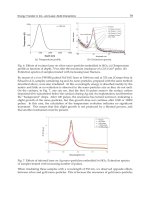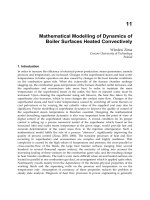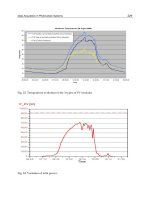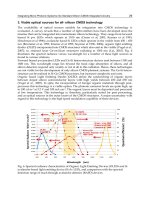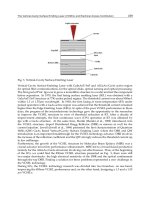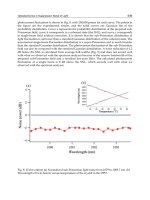Mechatronic Systems Applications Part 15 potx
Bạn đang xem bản rút gọn của tài liệu. Xem và tải ngay bản đầy đủ của tài liệu tại đây (574.07 KB, 9 trang )
InstallationofMechatronicsEducationUsingthe
MindStormsforDept.ofMechanicalEngineering,O.N.C.T 345
3.4 Assemble a multi-legs robot
In the fourth session a guide book for MindStorms written in Japanese (Sato. 2000) is used as
a manual to assemble a mobile robot. This book shows how to assemble several types of
robot, such as multi-legs walking robot and wheel type mobile robot and so on. Fig. 5 shows
a multi-legs walking robot named Musimusi No.5, which can be built by reference to the
study guide. It averagely took about an hour and a half to complete this robot.
Fig. 5. Six legs autonomous robot, Musimusi No. 5
3.5 Programming
RCX is a delicate controller for MindStorms which has a 8 bit micro processor. It has three
input ports and three output ports. Fig. 6 shows a RCX connecting with a motor, a lamp, a
touch sensor, and a light sensor. A GUI based programming software, Robolab, is prepared
as a regular programming software of MindStroms. Fig. 7 shows a programming
environment of Robolab, where only users align command icons and connect them with
wires in order to control some motors and actuators of MindStorms. All control command
icon is prepared in the function panel. Operation commands for icons like wires can be
selected on the tool panel as shown in Fig. 7. This programming environment of Robolab is
well-suited to the beginners because of its friendliness, and makes it possible to code some
high-level programming techniques such as conditional branching and infinite loop, etc.
Since this mechatronics course has to be implemented in short space of time, teachable
programming techniques are restricted. Fortunately some fundamental programs are
previously installed in software for self-education then there is no difficulties to introduce
the basic function of Robolab and make students to understand a signal flow of program.
After students understand and run the programs by using RCX, they try to make the
programs working out several instructions in order to cultivate their programming ability.
The following itemized instructions is an example of the training, and its corresponding
program is shown in Fig. 7.
I. When the touch sensor mounted at port 1 is pressed, then both of motors mounted at port
A and C rotate in left direction for three seconds.
II. When the touch sensor mounted at port 1 is pressed again, both of motors mounted at
port A and C rotate in right direction.
III. When the touch sensor mounted at port 1 is pressed, then the rotating two motors stop.
Fig. 6. A configuration of RCX, which connects with actuators and sensors.
Fig. 7. Graphical user interface of Robolab
3.6 Obstacle course
Through the fourth and fifth sessions, students experienced a basic method to assemble a
movable robot and learned how to code a program of ROBOLAB which controls the sensors
and motors. A research factor of robot engineering is involved in the final session, where
students try to make a mobile robot getting up to the goal with avoiding and/or overriding
some obstacles on the field.
Only the final session, students are divided into five teams, then each team consists of two
or three students. This team formation aims to avoid the restriction due to a number of
MechatronicSystems,Applications346
components of MindStorms, and to make up for each other's deficiencies. A problem field is
informed to student after the fifth session, and then students begin to think a strategy where
they proposed shape and mechanism of robot and program code are proposed with each
other within one week. In the final session students can use total 150 minutes for assembling
and coding their robot and program, and the remaining time is used for competition. Of
course there is no problem to exchange of opinions with other teams, and change their
strategy they thought. Before the competition, they explain their strategy and the function of
the developed robot.
The teams of the first group challenge a field of obstacle course shown in Fig. 8(a), where
two obstacles are fixed between the start area and the goal area. A robot has to recognize the
obstacles by using using touch sensors and change the direction of movement to avoid the
obstacles.
Fig. 8(b) shows the second group's field of obstacle course, where an object which is twenty
centimetres square by ten centimetres height is fixed in the centre of the field. A robot has to
have functions that enables the robot to go strait and go around the obstacle in light
direction. Only two rules a robot has to follow are that a robot must not contact the obstacle
and take over the outer square line.
The third group's students try to make a robot that is able to go up the stairs. Fig. 8(c) shows
a scheme of the field of obstacle course. The height of each step is five centimetres and and
the width is fifteen centimetres. This stair-like obstacle is fixed at one meter distance from
the start line, so the robot has to not only go straight and climb the stairs.
In the fourth problem three hurdles made of rubber grips are used as the obstacles. Fig. 8(d)
shows a scheme of the fourth field of obstacle course. The hurdles are assigned fifteen
centimetres apart and these height are one, two, and three centimetres from the floor.
Additionally, hurdle's stiffness escalates afterward.
Fig. 8.(a) Scheme of the first obstacle course
Fig. 8.(b) Scheme of the second obstacle course
Fig. 8.(c) Scheme of the third obstacle course
Fig. 8.(d) Scheme of the fourth obstacle course
InstallationofMechatronicsEducationUsingthe
MindStormsforDept.ofMechanicalEngineering,O.N.C.T 347
components of MindStorms, and to make up for each other's deficiencies. A problem field is
informed to student after the fifth session, and then students begin to think a strategy where
they proposed shape and mechanism of robot and program code are proposed with each
other within one week. In the final session students can use total 150 minutes for assembling
and coding their robot and program, and the remaining time is used for competition. Of
course there is no problem to exchange of opinions with other teams, and change their
strategy they thought. Before the competition, they explain their strategy and the function of
the developed robot.
The teams of the first group challenge a field of obstacle course shown in Fig. 8(a), where
two obstacles are fixed between the start area and the goal area. A robot has to recognize the
obstacles by using using touch sensors and change the direction of movement to avoid the
obstacles.
Fig. 8(b) shows the second group's field of obstacle course, where an object which is twenty
centimetres square by ten centimetres height is fixed in the centre of the field. A robot has to
have functions that enables the robot to go strait and go around the obstacle in light
direction. Only two rules a robot has to follow are that a robot must not contact the obstacle
and take over the outer square line.
The third group's students try to make a robot that is able to go up the stairs. Fig. 8(c) shows
a scheme of the field of obstacle course. The height of each step is five centimetres and and
the width is fifteen centimetres. This stair-like obstacle is fixed at one meter distance from
the start line, so the robot has to not only go straight and climb the stairs.
In the fourth problem three hurdles made of rubber grips are used as the obstacles. Fig. 8(d)
shows a scheme of the fourth field of obstacle course. The hurdles are assigned fifteen
centimetres apart and these height are one, two, and three centimetres from the floor.
Additionally, hurdle's stiffness escalates afterward.
Fig. 8.(a) Scheme of the first obstacle course
Fig. 8.(b) Scheme of the second obstacle course
Fig. 8.(c) Scheme of the third obstacle course
Fig. 8.(d) Scheme of the fourth obstacle course
MechatronicSystems,Applications348
4. Result
This mechatronics installation course aims to make students to briefly know not only basic
concepts of mechatronics but also difficulties of manufacturing. A toolkit of Mindstorms has
an infinite of design freedom, so that this toolkit is able to foster students' creativity and
design talent. Most of students had worked at this mechatronics installation course in
earnest and developed interests in mechatronics. After learning basic techniques to assemble
a movable robot and write a programming code, students addressed the challenge of
obstacle course at the final session.
Fig. 9 shows two robots that could accomplish to clear the first obstacle course as shown in
Fig. 8 (a). One is a type of autonomous robot that mounts RCX on its body and employed a
rear-wheel-drive system. Students assumed that the functions required for a robot are to
recognize accurately the surface of obstacle's wall, to keep going straight, and to change the
direction of movement orthogonally. Firstly the robot moves toward the obstacle 1. After
recognizing the surface of obstacle 1 by using the touch sensor fixed in front of body, the
robot once goes back to turn a right and goes forward to the obstacle 2. After that, the robot
goes to the goal in the same matter used to avoidance the obstacle 1.
On the contrary the robot shown in Fig. 9 (b) is manually controlled by the students. They
used a RCX as a manual controller so that no sensors are mounted on the robot. The
direction of movement is changed by differently adjusting the motor powers. The control
signal is transmitted to the motor according to the timing of the student pushes a touch
sensor mounted on RCX.
(a) Autonomous robot (b) Manual control robot
Fig. 9. Robots for the first obstacle avoidance problems
Fig. 10. An experimental scene of the second obstacle course
Touch SensorTouch Sensor
CaterpillarCaterpillar
Obstacle
Robot
Obstacle
Robot
Fig. 10 shows a scene of the competition of the second team. Unexpectedly only one robot
shown in Fig. 10 could clear this obstacle course. Most of robot could not take a roundabout
route within the outer square line. The team employed a four wheel drive system, however
different sized wheels used in left and right sides in order to reduce turning radius of the
robot. This team spent most of time to adjust their program of RCX by repeating test run,
because rotational speeds of left and right motors have to be asymmetrically controlled even
to keep going straight.
Five teams addressed the third problem shown in Fig. 8 (c). Most of teams aimed to climb
the stairs by driving front wheels as shown in Fig. 11(a), however, no team could climb even
the first step by using this way, they ended in failure due to the weight of RCX. Only one
robot could complete the stair-like obstacle course. Fig. 11(b) shows an overview of the robot
and describes its body's degrees of freedoms, where the lack gear moves along the joint q1
in order to lift up the front caterpillar. The q2 shows the angle of gradient for the front
caterpillar. A remote control system is adopted in order to trim the weight of robot.
Along the following five steps, shown in Fig. 9(c), the robot climbed up stairs in the
experiment; (1) the robot moves toward the stairs with fixing the angle of front caterpillar
and quit going forward in front of the stairs. (2) Using the movable joints q1 and q2, the
robot puts a part of front caterpillar on the first step. (3) The robot got back to the beginning
posture as well as (1) on the first step. (4) The robot repeated the previous three behaviours
once more to get the top of the stairs. (5) The robot arrived at the goal at last.
Fig 11.(a) An example of robot ended in failure for the third obstacle course
Wheels for climbing
Caterpillar
InstallationofMechatronicsEducationUsingthe
MindStormsforDept.ofMechanicalEngineering,O.N.C.T 349
4. Result
This mechatronics installation course aims to make students to briefly know not only basic
concepts of mechatronics but also difficulties of manufacturing. A toolkit of Mindstorms has
an infinite of design freedom, so that this toolkit is able to foster students' creativity and
design talent. Most of students had worked at this mechatronics installation course in
earnest and developed interests in mechatronics. After learning basic techniques to assemble
a movable robot and write a programming code, students addressed the challenge of
obstacle course at the final session.
Fig. 9 shows two robots that could accomplish to clear the first obstacle course as shown in
Fig. 8 (a). One is a type of autonomous robot that mounts RCX on its body and employed a
rear-wheel-drive system. Students assumed that the functions required for a robot are to
recognize accurately the surface of obstacle's wall, to keep going straight, and to change the
direction of movement orthogonally. Firstly the robot moves toward the obstacle 1. After
recognizing the surface of obstacle 1 by using the touch sensor fixed in front of body, the
robot once goes back to turn a right and goes forward to the obstacle 2. After that, the robot
goes to the goal in the same matter used to avoidance the obstacle 1.
On the contrary the robot shown in Fig. 9 (b) is manually controlled by the students. They
used a RCX as a manual controller so that no sensors are mounted on the robot. The
direction of movement is changed by differently adjusting the motor powers. The control
signal is transmitted to the motor according to the timing of the student pushes a touch
sensor mounted on RCX.
(a) Autonomous robot (b) Manual control robot
Fig. 9. Robots for the first obstacle avoidance problems
Fig. 10. An experimental scene of the second obstacle course
Touch SensorTouch Sensor
CaterpillarCaterpillar
Obstacle
Robot
Obstacle
Robot
Fig. 10 shows a scene of the competition of the second team. Unexpectedly only one robot
shown in Fig. 10 could clear this obstacle course. Most of robot could not take a roundabout
route within the outer square line. The team employed a four wheel drive system, however
different sized wheels used in left and right sides in order to reduce turning radius of the
robot. This team spent most of time to adjust their program of RCX by repeating test run,
because rotational speeds of left and right motors have to be asymmetrically controlled even
to keep going straight.
Five teams addressed the third problem shown in Fig. 8 (c). Most of teams aimed to climb
the stairs by driving front wheels as shown in Fig. 11(a), however, no team could climb even
the first step by using this way, they ended in failure due to the weight of RCX. Only one
robot could complete the stair-like obstacle course. Fig. 11(b) shows an overview of the robot
and describes its body's degrees of freedoms, where the lack gear moves along the joint q1
in order to lift up the front caterpillar. The q2 shows the angle of gradient for the front
caterpillar. A remote control system is adopted in order to trim the weight of robot.
Along the following five steps, shown in Fig. 9(c), the robot climbed up stairs in the
experiment; (1) the robot moves toward the stairs with fixing the angle of front caterpillar
and quit going forward in front of the stairs. (2) Using the movable joints q1 and q2, the
robot puts a part of front caterpillar on the first step. (3) The robot got back to the beginning
posture as well as (1) on the first step. (4) The robot repeated the previous three behaviours
once more to get the top of the stairs. (5) The robot arrived at the goal at last.
Fig 11.(a) An example of robot ended in failure for the third obstacle course
Wheels for climbing
Caterpillar
MechatronicSystems,Applications350
Fig. 11.(b) An overview of the robot completed the third obstacle course
Fig. 11.(c) Experimental scenes going up the stairs in the third obstacle course
Fig. 12.(a) A tank type robot with double arms for the forth obstacle course
Fig. 12.(b) A long leg type robot for the forth obstacle course
Fig. 12 shows the robots could clear the forth obstacle course shown in Fig. 8(d). The robot
shown in Fig. 12(a) rotates the front arm along the direction of q1 for the three purposes of
the followings; (a) lifting the body up, (b) breaking down the rubber hurdles, and (c) going
forward. The tires equipped at the end of arms does not rotate to go forward. As the result,
this robot became entangled with rubbers several times, however, it finally could ride over
all hurdles.
The robot, as shown in Fig. 12(b), only goes straight by rotating swastika shaped legs. These
legs always lift the body higher than the rubber hurdles and enabled the robot to get the
goal without the legs hitch the rubber hurdles.
According to the result of questionnaire about this mechatronics course, the following
answers are received; all students had the interests in mechatronics, 68% of students were
highly interested in the obstacle course conducted in the final session, and 17% of students
were especially concerned with RCX programming. The others concerned with making the
mechanical modules by using MindStorms, the miniature automation line system, and the
assembling a multi-legged robot at the same rate.
4. Discussion and Conclusion
The author constructed an installation course of mechatronics and conducted on the
students of department of mechanical engineering, Oita national college of technology. The
course is composed of six sessions and is aiming to grow up the mechanical engineers who
can adapt quickly to changes in industrial society. Then, the education programs of
computer technology and information processing are more emphasized in this course.
Certainly the specific subjects involved with mechatronics are constructed as a part of
curriculum in the older grades, however there is some difficulties to make students of
department of mechanical engineering to have interests in electronics and/or information
science. Viewed in this light, it is better to begin mechatronics education with undergoing
experiments like this course since they were in early grade.
This course employed the obstacle course as the final project. Working at making a robot for
obstacle environment provides a research factor for students. They have an opportunity to
InstallationofMechatronicsEducationUsingthe
MindStormsforDept.ofMechanicalEngineering,O.N.C.T 351
Fig. 11.(b) An overview of the robot completed the third obstacle course
Fig. 11.(c) Experimental scenes going up the stairs in the third obstacle course
Fig. 12.(a) A tank type robot with double arms for the forth obstacle course
Fig. 12.(b) A long leg type robot for the forth obstacle course
Fig. 12 shows the robots could clear the forth obstacle course shown in Fig. 8(d). The robot
shown in Fig. 12(a) rotates the front arm along the direction of q1 for the three purposes of
the followings; (a) lifting the body up, (b) breaking down the rubber hurdles, and (c) going
forward. The tires equipped at the end of arms does not rotate to go forward. As the result,
this robot became entangled with rubbers several times, however, it finally could ride over
all hurdles.
The robot, as shown in Fig. 12(b), only goes straight by rotating swastika shaped legs. These
legs always lift the body higher than the rubber hurdles and enabled the robot to get the
goal without the legs hitch the rubber hurdles.
According to the result of questionnaire about this mechatronics course, the following
answers are received; all students had the interests in mechatronics, 68% of students were
highly interested in the obstacle course conducted in the final session, and 17% of students
were especially concerned with RCX programming. The others concerned with making the
mechanical modules by using MindStorms, the miniature automation line system, and the
assembling a multi-legged robot at the same rate.
4. Discussion and Conclusion
The author constructed an installation course of mechatronics and conducted on the
students of department of mechanical engineering, Oita national college of technology. The
course is composed of six sessions and is aiming to grow up the mechanical engineers who
can adapt quickly to changes in industrial society. Then, the education programs of
computer technology and information processing are more emphasized in this course.
Certainly the specific subjects involved with mechatronics are constructed as a part of
curriculum in the older grades, however there is some difficulties to make students of
department of mechanical engineering to have interests in electronics and/or information
science. Viewed in this light, it is better to begin mechatronics education with undergoing
experiments like this course since they were in early grade.
This course employed the obstacle course as the final project. Working at making a robot for
obstacle environment provides a research factor for students. They have an opportunity to
MechatronicSystems,Applications352
discuss about their strategy to make a robot and they can experience concurrent engineering
between assembly of robot and design of the controller. Meanwhile, development of a line
tracing robot based on MindStorms has commonly used as a training issue in mechatronics
education. A line tracing robot generally consists of mechanisms, light sensors, and motors.
Additionally, a repeatable structure program is necessary. Most of mechatronics factors are
contained in making a line tracing robot, however, there are lots of information about line
tracing robot based on MindStorms and Robolab on the Internet. Certainly, difficulties of
line tracing robot can be increased by changing the line width and/or the path of line. The
reason why obstacle course is employed as the final project of the mechatronics course is
that nobody knows an appropriate solution corresponding to obstacle environments.
Students worked in a team to address each given environment. Obstacle environment had to
be different corresponding to students' growth through the year, so that the evaluation
method for students' grade must not focus on the result of the final problem. In this course
the grade of student is evaluated from their submitted reports for every session, where their
activeness and written description of their impressions for each sessions become mainly
evaluation object.
It was difficult to keep enough time to make students to learn programming techniques of
Robolab such as branch connection and conditional statement, so that some students could
not know convenience of programming for controlling actuators. Increment of the
programming session make it possible to enhance the quality of robot and raise success rate
of the final project. Temporal distribution of every kind of mechatronics contents is the most
important problem.
5. References
Jin SATO. (2000). TETSUJIN Technique for MindStorms of Jin Sato, Ohmsha, ISBN 4-274-08682-
8, Japan.
Jiro Eto, Yuki SHIRAKAWA, Tetsuro MAKISE, Jin SATO, Daisuke Kurabayashi, and Go
FURUKAWA. (1999). LEGO MINDSTORMS Perfect guide, Shueisha, ISBN 978-4-
88135-769-9, Japan.
Chieko KOMATSU, Toshikazu MINOSHIMA, and Takafumi MATSUMARU. (2000).
Effeciency of experimental study on Mechatronics by using the LEGO MindStorm,
Proceedings of Robotics and Mechatronics, Kumamoato prefecture, Japan, May and
2000, 1A1-81-128, (In Japanese).
Tomoyuki NAKASHIMA, Hiyoshi HAGIWARA, and Takafunmi MATSUMARU. (2001).
Learning by Experience System on Mechatronics using LEGO MindStorms, Proceedings
of Robotics and Mechatronics 2A1-A2, Kagawa prefecture, Japan, June and 2001
Eiichi INAGAKI, Yoshiaki SAWA, and Hiroyuki Okamura. (2001). Practical Education by
using LEGO MindStorms at a Lecture Room, Proceedings of Robotics and
Mechatronics 2P1-A2, Kagawa prefecture, Japan, June and 2001
